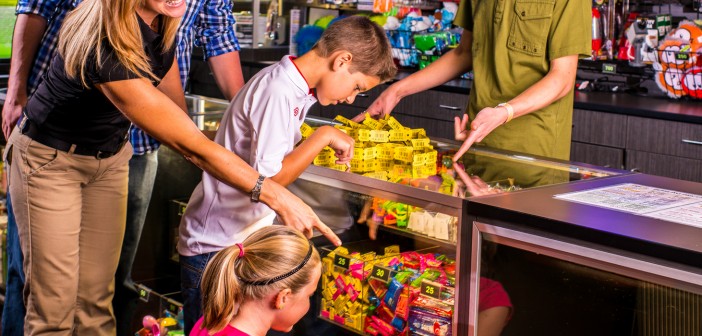How to Lose Money…
And Make Your Accountant Happy
By George McAuliffe, Chief FEC Strategist, Redemption Plus

George McAuliffe
I struggled with the headline for this column. I didn’t want to insult all accountants, especially the great ones who understand that saving a dollar doesn’t necessarily mean that you made a dollar. It’s not just accountants, either. Plenty of operating managers miss the big picture by focusing too narrowly in certain areas.
Sure it’s important to control redemption cost of sales, but it has to be done in the context of the overall guest experience, which takes place throughout a facility. Redemption is only a part of the experience, yet, as this story will tell, it can often have an outsized impact.
This is a true story. Regular readers may remember my niece, Tara. She’s the mother of three kids ages 11, 7 and 5, and grew up playing games in arcades and enjoying redemption. Now her kids are playing, on their own and with their parents. Between summers on the boardwalk, birthday parties, and general family entertainment, the arcade is on their “fun menu” fairly often.
Tara and her husband, James, recently planned a family vacation to a resort in the Pocono Mountains. While the main activity at this resort in January is skiing, the property offers a waterpark, large arcade, ropes course, climbing wall and other attractions. Over three days, the family spent $1,800-2,000 in the resort, including meals, room charges, ski passes and entertainment. About $125 of that was spent in the arcade.
Knowing what I do for a living, they gave me a full report when the family returned home. They had had a great time and were especially happy with the arcade. Tara liked the assortment of fun games and she was especially happy with the toys the kids won for redeeming their tickets. As a parent, she felt like they had gotten their money’s worth and was happy to see her kids smiling. The kids all felt they had accomplished something by winning multiple “great prizes!”
So that was that. Until a week or two later when my phone rang with another report. Tara had been at a school event talking to another Mom when the conversation turned to what their families did on the winter break. Tara raved about her “Resort A” experience. The friend, who had stayed at “Resort B” a few miles away, asked for details. Tara talked about how great the arcade experience was. To which her friend said “No way! That was what killed the vacation for us at Resort B!”
She went on to describe a pretty grim redemption experience. After spending about the same as Tara’s family, $125 or so over three days at the arcade, the friend and her kids went to cash in their tickets. Two of the kids had enough tickets for “a few Tootsie Rolls.” The youngest daughter, who was five, had spent most of her credits trying (fruitlessly) to win a plush animal in a crane and did not have enough tickets for anything. When her Mom, with 5-year-old in tow, asked the attendant if she could just give her a tootsie roll or two, the attendant refused blaming “company policy.” The 5-year-old then burst into tears!
How different could two experiences be? And I happen to know that the same game operator handles the game room in both resorts!
The difference is that in Resort A, the operator handles the redemption merchandise and in Resort B the resort handles it. You can imagine the end of the story: Tara’s friend is going to Resort A next year. Both moms will continue to share their respective experiences with friends.

Guest experience directly affects your bottom line, and that includes your redemption center. Don’t be penny wise and prize foolish.
Let’s take a look at the numbers:
The happy family spent $125 in the arcade and received prizes with a (wholesale) merchandise value of about $30 (24 percent). Next year, that experience will return another $1,800 from Tara’s family, $1,800 from her friend, and some additional number from other friends who hear the two moms tell their stories.
So the $30 in prizes, while representing a 24 percent cost of arcade sale contributed to an estimated $3,600-$5,000 in future business.
The unhappy family at Resort B’s arcade also spent $125 in the arcade, but received only about $1 in wholesale value of prizes, less than 1 percent (low by any measure, my guess is that disproportionate crane play without a win pushed that percentage down, but payouts were clearly set too low to begin with).
Result for Resort B: While it runs a much lower arcade cost of sales percentage, they have lost at least one customer at $1,800 per visit and probably many more. What did Resort B “save?” Just $29 in merchandise cost.
Score? Resort A wins with at least +$3,570 in net revenue versus Resort B’s -$1,771 (that’s right, a negative, and probably higher losses).
That’s an example of the central role redemption can play in your guest’s experience. The same scenario plays out in FECs across the world every week. The prize takeaway is a huge part of the guest’s value perception for your center. That value perception is a critical driver of whether they will return to your facility, and how often.
George McAuliffe has created and operated family entertainment centers from 2,000 to 150,000 square feet as a corporate executive, entrepreneur and consultant. He’s President of Pinnacle Entertainment Group and leads the company’s strategic advisory team. George, recently moved back “home” to the Jersey Shore with his wife Julie, has a passion for passing along what he’s learned in the fun business to the new generation of operators and suppliers.
Readers can visit grouppinnacle.com for more information or contact George at georgemc@group
pinnacle.com; phone: 314-422-7197.





1 Comment
OMG $125 and they wouldn’t even give a little kid a tootsie roll! That is the cheapest thing I ever heard! You get better comps in Vegas lol